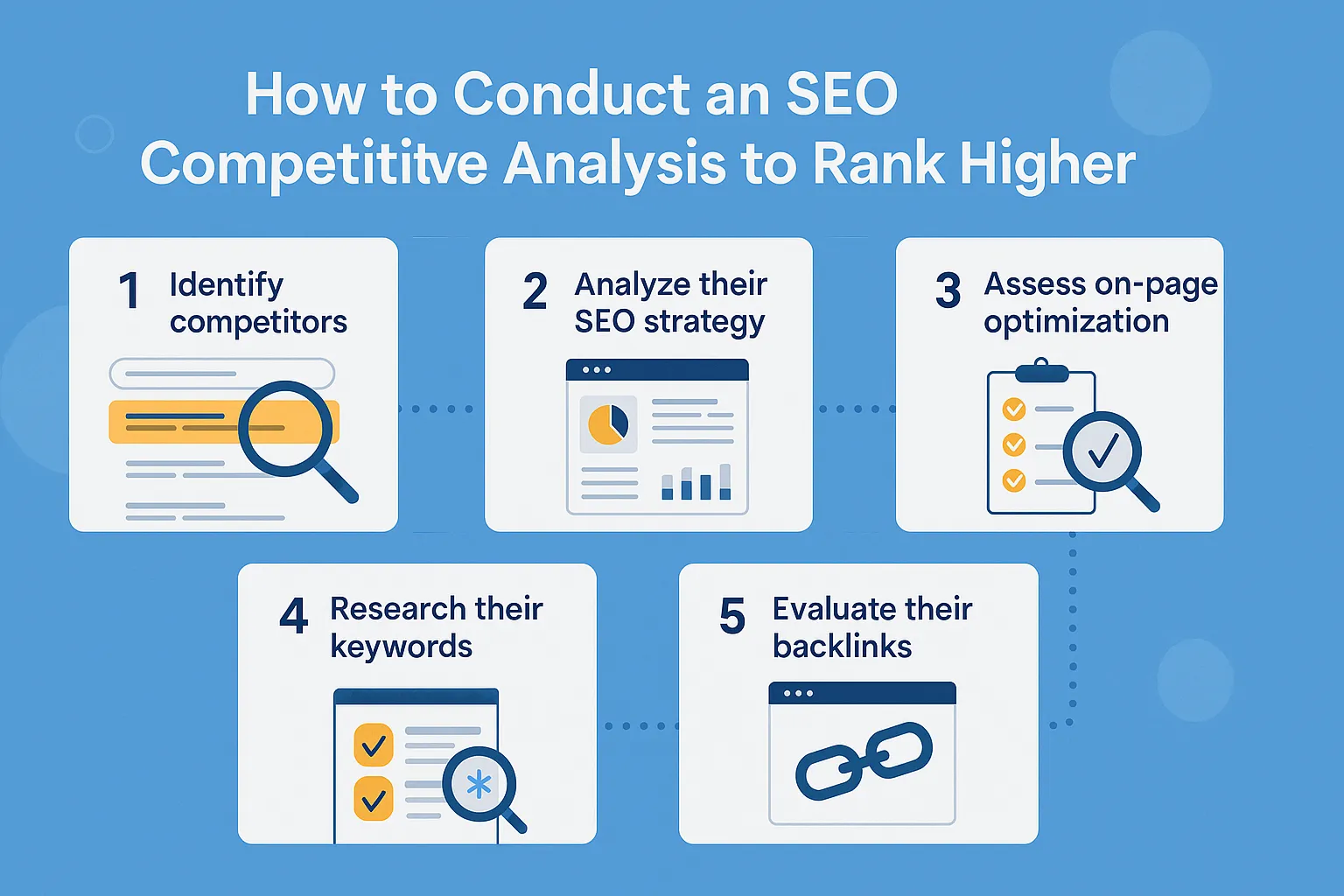Search Engine Optimization (SEO) is vital for online businesses aiming to attract organic traffic. Ranking high on search engine results pages (SERPs) is critical, as the top Google result enjoys a 27% click-through rate, while second-page results drop to just 0.63% (Backlinko). An SEO competitive analysis helps you understand your competitors’ strategies, identify their strengths and weaknesses, and craft a plan to outrank them. This guide outlines five essential steps to perform an effective SEO competitive analysis.
Step 1: Identify Your Competitors
Knowing your competitors is the foundation of an SEO competitive analysis. Start by listing businesses or websites ranking for your target keywords. For example, if you’re targeting “SEO trends 2025,” check which sites hold the top spots, such as Wordstream or Search Engine Journal.
How to Find Competitors
- Search for Your Keywords: Use Google to identify websites ranking for your primary keywords.
- Use SEO Tools: Tools like SEMrush’s Competitive Analysis tab or KWFinder reveal competitors targeting similar keywords, including those you might not have considered.
This step ensures you focus on the right players in your niche, setting the stage for deeper analysis.
Step 2: Analyze Their SEO Strategy
Understanding your competitors’ SEO strategies provides insights into their success. Visit their websites to evaluate:
- Website Structure: Is their site user-friendly and mobile-optimized? Use Google’s PageSpeed Insights and Mobile-Friendly Test to assess technical SEO.
- Content Types: Identify whether they rely on blogs, landing pages, or eBooks to attract traffic.
- Keyword Focus: Note the balance of broad and specific keywords they target.
Content Analysis
Use tools like BuzzSumo to find their top-performing pages and determine:
- Which pages rank for your target keywords?
- Which content drives the most traffic?
- What topics resonate with their audience?
Social Media Presence
Examine their social media activity to understand how they drive traffic. Check:
- Engagement levels and follower count.
- Types of content shared (e.g., videos, infographics).
- How they use social platforms to boost brand visibility.
This analysis reveals gaps in your strategy and opportunities to differentiate.

Step 3: Analyze Their Keywords
Keyword analysis is key to outranking competitors. Focus on:
- Primary Keywords: Are you ranking well for your main keywords, or are you stuck at the bottom of page one?
- Keyword Gaps: Use SEMrush or Ahrefs to identify keywords your competitors rank for but you don’t.
- Low-Hanging Fruit: Target less competitive, related keywords to climb the rankings faster.
Actionable Tips
- Review competitors’ pages for high-traffic keywords they’ve overlooked.
- Optimize your content with these keywords to capture missed opportunities.
- Monitor keyword performance regularly, as rankings can fluctuate.
By targeting strategic keywords, you can surpass competitors and improve your SERP position.
Step 4: Analyze Their On-Page Optimization
On-page optimization significantly impacts rankings. Analyze competitors’ high-ranking pages to understand their approach. Key elements to review include:
- Title Tags: Ensure titles are keyword-rich, concise (under 60 characters), and relevant.
- Meta Descriptions: Check if they craft compelling, keyword-focused meta descriptions (under 160 characters).
- Header Tags: Google prioritizes H1 and H2 tags, especially when tied to keywords. Ahrefs notes that H1 tags are used in place of title tags 51% of the time.
- Internal Linking: Strong internal links guide users to relevant content and boost SEO.
- Content Quality: High-quality, relevant content outperforms quantity. Study competitors’ top blogs to identify authoritative content.
- Image/Video Optimization: Ensure images and videos have descriptive, keyword-rich names and alt text.
- Structured Data: Schema markup enhances visibility in SERPs.
- URLs: Clear, keyword-rich URLs perform better.
- User Experience: Evaluate navigation, page speed, and mobile-friendliness.
Implement these optimizations to match or exceed competitors’ performance.
Step 5: Analyze Their Backlinks
Backlinks are a critical ranking factor. Use tools like Ahrefs, SEMrush, or Moz to analyze competitors’ backlink profiles. Focus on:
- Quality Over Quantity: High-authority backlinks (e.g., from Wired) carry more weight than numerous low-quality links.
- Competitor Backlink Sources: Identify sites linking to competitors and pitch them for your content.
- Outreach Opportunities: Reach out to reputable sites for guest posts or collaborations to build high-quality backlinks.
By replicating or improving on competitors’ backlink strategies, you can boost your site’s authority and rankings.
Why Regular SEO Competitive Analysis Matters
SEO is dynamic, with trends and algorithms constantly evolving. Regular competitive analysis keeps you ahead by:
- Identifying new competitors and strategies.
- Uncovering keyword and content opportunities.
- Strengthening your backlink profile and on-page SEO.
Table of Contents
Key Takeaway
SEO competitive analysis in 2025 is not a one-time task — it’s an ongoing process. By regularly tracking competitor strategies, keyword shifts, on-page optimization, and backlinks, you’ll stay ahead of evolving algorithms and competitors alike.
Invest time into this process and you’ll create a sustainable strategy that keeps your business visible, competitive, and growing.



